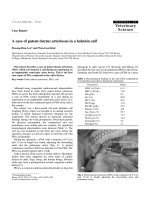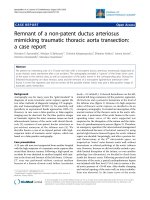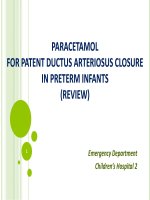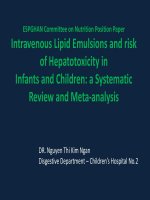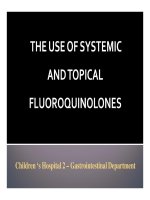Update on mangement of patent ductus arteriosus in preterm infants | Website Bệnh viện nhi đồng 2 - www.benhviennhi.org.vn
Bạn đang xem bản rút gọn của tài liệu. Xem và tải ngay bản đầy đủ của tài liệu tại đây (853.71 KB, 34 trang )
Update on mangement of
patent ductus arteriosus in
preterm infants
Dr. Trinh Thi Thu Ha
Outline
1. Overview of PDA
2. Timing of screening PDA?
3. When to treat PDA?
Timing of
ductal
closure
Prenatal MgSO4, tocolytic
Postnatal surfactant
Early, severe pulmonary hemorrhage is
associated with ductal patency at 12 to 18 hours
of age, but later pulmonary hemorrhage (after the
first week) is not related to persistent ductal
patency
(Workbook in Practical Neonatology 5th Edition 2015)
Diagnosis: In most cases, the clinically silent
PDA during the first few days goes undetected
unless an echocardiogram is performed
Signs of bounding pulses, active precordium, and
systolic murmur were of reasonable specificity but
very low sensitivity in the first 3 to 4 days of birth
for diagnosis of an echocardiographically defined
significant PDA
Relying on clinical signs alone led to a mean
diagnostic delay of 2 days
(A blinded comparison of clinical and echocardiographic evaluation of the
preterm infant for patent ductus arteriosus.Skelton R1, Evans N, Smythe J.
JPaediatr Child Health. 1994 Oct;30(5):406-11)
Timing of screening PDA?
• Objective: To evaluate the association between
early screening echocardiography for PDA and
in-hospital mortality
• Exposures: Early screening echocardiography
before day 3 of life.
• Design, Setting, and Participants:
National prospective population-based cohort
All preterms <=29 weeks hospitalized in 68 NICU
in France from April through December 2011.
• Main Outcomes and Measures:
Death between day 3 and discharge.
Neonatal morbidities (pulmonary
hemorrhage, severe bronchopulmonary
dysplasia, severe cerebral lesions, and
necrotizing enterocolitis).
Result
1210 preterm infants
Treat for PDA more frequently (55.1% vs 43.1%;
[OR], 1.62 [95% CI, 1.31 to 2.00]
Lower in-hospital mortality (55.1% vs 43.1%;
OR, 0.73 [95% CI, 0.54 to 0.98])
Lower risk of pulmonary hemorrhage (5.6% vs
8.9%; OR, 0.60 [95% CI, 0.38 to 0.95]
No different in severe BPD, severe cerebral
lesions, and NEC
Treatment
Options for dealing with PDA in preterm infants:
(1) Prophylactic pharmacologictreatment (COX
inhibitors),
(2) Pre-symptomatic pharmacologic treatment of PDA,
(3) Symptomatic pharmacologic treatment of PDA
Conservative management,
Pharmacological closure of the PDA
Surgical ligation.
Percutaneous transcatheter occlusion
Prophylactic Pharmacotherapy ?
Administering COX inhibitors (indomethacin or
ibuprofen) within the first 24h of life irrespective of
the diagnosis of PDA
Indomethacin is the best studied with 2872 babies randomised in 19 trials
Indomethacin Prophylaxis
Some clinicians recommend indomethacin prophylaxis for
extremely immature babies (23–25 weeks) to prevent IVH
At this time, less than 30% of neonatologists in the United -States use indomethacin “prophylactically”, despite its shortterm benefits
(Jhaveri N, Soll RF, Clyman RI. Feeding practices and patent ductus arteriosus ligation preferences-are they
related? Am J Perinatol. 2009;27:667–674. [PubMed])
Ibuprofen Prophylaxis
No significant differences in mortality, IVH, or BPD
No reduction in IVH, PAL in the treated group
Increased risk of gastrointestinal bleeding
Prophylactic ibuprofen exposes many infants to renal and
gastrointestinal side effects without any important short-term
benefits and is not recommended
Pre-symptomatic
Pharmacologic Treatment
No effect on the rate of
mortality, BPD, IVH, ROP,
or length of ventilation,
death, IVH, NEC,…
More renal side effect
Presymptomatic
indomethacin or ibuprofen
therapy for PDA in preterm
infants is not recommended.
Conservative
Management
Fluid restriction
Diuretics, avoidance of loop diuretics
Maintaining a hematocrit of 35 to 40 percent
Increased positive airway pressure
Correction of alkalosis
Avoidance of pulmonary vasodilators: oxygen or NO
Asymptomatic infants with PDAs generally do not require
medical management or surgical ligation. These infants
should be monitored for evidence of CHF, failure or renal
impairment, increasing oxygen requirement, or other
complications
Pharmacological closure
• Indomethacine
• Ibuprofen
• Paracetamol (?)
33 studies, 2190 infants, iv and oral administration
